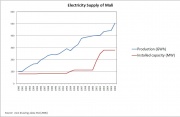Difference between revisions of "Mali Energy Situation"
***** (***** | *****) |
***** (***** | *****) |
||
| Line 1: | Line 1: | ||
| − | {| align="right | + | {| align="right" cellspacing="1" cellpadding="5" border="0" data-cke-expando="66" style="width: 400px; font-size: 14px" |
|- | |- | ||
| − | ! style="text-align: center; background-color: rgb(79,129,189); width: 602px | + | ! scope="col" colspan="4" style="text-align: center; background-color: rgb(79,129,189); width: 602px" | <font color="#ffffff"><span style="line-height: 20px">Republic of Mali</span></font> |
|- | |- | ||
| − | | style="text-align: center; background-color: rgb(219,229,241); width: 250px | + | | colspan="3" rowspan="1" style="text-align: center; background-color: rgb(219,229,241); width: 250px" | [[File:Mali Flag.gif|center|180px|Mali Flag|alt=Flag of _____.png]] |
| − | | style="text-align: center; background-color: rgb(219,229,241); width: 250px" | [[File:Mali Situation.gif|center|180px|Mali Location|alt=Location _______.png]] | + | | style="text-align: center; background-color: rgb(219,229,241); width: 250px" | [[File:Mali Situation.gif|center|180px|Mali Location|alt=Location _______.png]] |
|- | |- | ||
| − | | style="background-color: rgb(219,229,241); width: 250px | + | | colspan="3" style="background-color: rgb(219,229,241); width: 250px" | '''Capital''' |
| − | | style="background-color: rgb(219,229,241); width: 250px" | Bamako (12° 39′ 0″ N, 8° 0′ 0″ W) | + | | style="background-color: rgb(219,229,241); width: 250px" | Bamako (12° 39′ 0″ N, 8° 0′ 0″ W) |
|- | |- | ||
| − | | style="background-color: rgb(219,229,241); width: 250px | + | | colspan="3" style="background-color: rgb(219,229,241); width: 250px" | '''Official Languages(s)''' |
| − | | style="background-color: rgb(219,229,241); width: 250px" | | + | | style="background-color: rgb(219,229,241); width: 250px" | |
French | French | ||
|- | |- | ||
| − | | style="background-color: rgb(219,229,241); width: 250px | + | | colspan="3" style="background-color: rgb(219,229,241); width: 250px" | '''Government''' |
| − | | style="background-color: rgb(219,229,241); width: 250px" | Semi-Presidential Republic | + | | style="background-color: rgb(219,229,241); width: 250px" | Semi-Presidential Republic |
|- | |- | ||
| − | | style="background-color: rgb(219,229,241); width: 250px | + | | colspan="3" style="background-color: rgb(219,229,241); width: 250px" | '''President''' |
| − | | style="background-color: rgb(219,229,241); width: 250px" | Ibrahim Boubacar KEITA | + | | style="background-color: rgb(219,229,241); width: 250px" | Ibrahim Boubacar KEITA |
|- | |- | ||
| − | | style="background-color: rgb(219,229,241); width: 250px | + | | colspan="3" style="background-color: rgb(219,229,241); width: 250px" | '''Prime Minister''' |
| − | | style="background-color: rgb(219,229,241); width: 250px" | Oumar Tatum LY | + | | style="background-color: rgb(219,229,241); width: 250px" | Oumar Tatum LY |
|- | |- | ||
| − | | style="background-color: rgb(219,229,241); width: 250px | + | | colspan="3" style="background-color: rgb(219,229,241); width: 250px" | '''Total Area ''''''<span style="line-height: 21px">( </span>km²<span style="line-height: 21px">)</span>''' |
| − | | style="background-color: rgb(219,229,241); width: 250px" | 1,240,192 | + | | style="background-color: rgb(219,229,241); width: 250px" | 1,240,192 |
|- | |- | ||
| − | | style="background-color: rgb(219,229,241); width: 250px | + | | colspan="3" style="background-color: rgb(219,229,241); width: 250px" | '''Population''' |
| − | | style="background-color: rgb(219,229,241); width: 250px" | <div class="category_data">15,968,882 (July 2013 est.)</div> | + | | style="background-color: rgb(219,229,241); width: 250px" | <div class="category_data">15,968,882 (July 2013 est.)</div> |
|- | |- | ||
| − | | style="background-color: rgb(219,229,241); width: 250px | + | | colspan="3" style="background-color: rgb(219,229,241); width: 250px" | '''Rural Population''' |
| − | | style="background-color: rgb(219,229,241); width: 250px" | <br/> | + | | style="background-color: rgb(219,229,241); width: 250px" | <br/> |
|- | |- | ||
| − | | style="background-color: rgb(219,229,241); width: 250px | + | | colspan="3" style="background-color: rgb(219,229,241); width: 250px" | '''GDP (Nominal)''' |
| − | | style="background-color: rgb(219,229,241); width: 250px" | <div class="category_data">$10.18 billion (2012 est.)</div> | + | | style="background-color: rgb(219,229,241); width: 250px" | <div class="category_data">$10.18 billion (2012 est.)</div> |
|- | |- | ||
| − | | style="background-color: rgb(219,229,241); width: 250px | + | | colspan="3" style="background-color: rgb(219,229,241); width: 250px" | '''GDP Per Capita''' |
| − | | style="background-color: rgb(219,229,241); width: 250px" | <div class="category_data">$1,100 (2012 est.)</div> | + | | style="background-color: rgb(219,229,241); width: 250px" | <div class="category_data">$1,100 (2012 est.)</div> |
|- | |- | ||
| − | | style="background-color: rgb(219,229,241); width: 250px | + | | colspan="3" style="background-color: rgb(219,229,241); width: 250px" | '''Currency''' |
| − | | style="background-color: rgb(219,229,241); width: 250px" | West African CFA franc (XOF) | + | | style="background-color: rgb(219,229,241); width: 250px" | West African CFA franc (XOF) |
|- | |- | ||
| − | | style="background-color: rgb(219,229,241); width: 250px | + | | colspan="3" style="background-color: rgb(219,229,241); width: 250px" | '''Time Zone''' |
| − | | style="background-color: rgb(219,229,241); width: 250px" | GMT (UTC+0) | + | | style="background-color: rgb(219,229,241); width: 250px" | GMT (UTC+0) |
|- | |- | ||
| − | | style="background-color: rgb(219,229,241); width: 250px | + | | colspan="3" style="background-color: rgb(219,229,241); width: 250px" | '''Calling Code''' |
| − | | style="background-color: rgb(219,229,241); width: 250px" | +223 | + | | style="background-color: rgb(219,229,241); width: 250px" | +223 |
|- | |- | ||
| − | | style="background-color: rgb(219,229,241); width: 250px | + | | colspan="3" style="background-color: rgb(219,229,241); width: 250px" | '''Electricity Generation''' |
| − | | style="background-color: rgb(219,229,241); width: 250px" | <span data- | + | | style="background-color: rgb(219,229,241); width: 250px" | <span data-scayt_word="twh" data-scaytid="5">0.52 TWh</span>/year (year) |
|- | |- | ||
| − | | style="background-color: rgb(219,229,241); width: 250px | + | | colspan="3" style="background-color: rgb(219,229,241); width: 250px" | '''Access to Electricity''' |
| − | | style="background-color: rgb(219,229,241); width: 250px" | | + | | style="background-color: rgb(219,229,241); width: 250px" | |
urban: 59%; rural: 14% | urban: 59%; rural: 14% | ||
|- | |- | ||
| − | | style="background-color: rgb(219,229,241); width: 250px | + | | colspan="3" style="background-color: rgb(219,229,241); width: 250px" | '''Wind energy (installed capacity)''' |
| − | | style="background-color: rgb(219,229,241); width: 250px" | MW (year) | + | | style="background-color: rgb(219,229,241); width: 250px" | MW (year) |
|- | |- | ||
| − | | style="background-color: rgb(219,229,241); width: 250px | + | | colspan="3" style="background-color: rgb(219,229,241); width: 250px" | '''Solar Energy (installed capacity)''' |
| − | | style="background-color: rgb(219,229,241); width: 250px" | MW (year) | + | | style="background-color: rgb(219,229,241); width: 250px" | MW (year) |
|} | |} | ||
| − | {| align="left" | + | {| align="left" cellspacing="1" cellpadding="1" border="0" style="width: 350px" class="FCK__ShowTableBorders" |
|- | |- | ||
| __TOC__ | | __TOC__ | ||
| Line 69: | Line 69: | ||
|} | |} | ||
<div style="clear: both"></div> | <div style="clear: both"></div> | ||
| − | + | <br/> | |
= Overview = | = Overview = | ||
| − | + | == (Primary) Energy supply and Consumption == | |
At 78% of a 3500 kToe annual primary energy supply, biomass, mainly in the form of wood and charcoal for domestic use, plays the dominant role in the Malian energy balance. | At 78% of a 3500 kToe annual primary energy supply, biomass, mainly in the form of wood and charcoal for domestic use, plays the dominant role in the Malian energy balance. | ||
| Line 81: | Line 81: | ||
The remaining 4% of the primary energy supply is largely made up of renewably generated electricity, mainly by hydropower. | The remaining 4% of the primary energy supply is largely made up of renewably generated electricity, mainly by hydropower. | ||
| + | On the energy consumption side, households consume 86 % of Mali’s energy, (road) transport 10 %, industry (mainly mining) 3 % and agriculture 1 % (2003 figures). | ||
| + | |||
| + | <br/> | ||
| − | + | == Electricity provision == | |
An estimated 20% of the fuel import is used for grid based electricity production through approximately 170 MW installed capacity, corresponding to roughly half the total generation capacity, where the other half consists of hydropower. | An estimated 20% of the fuel import is used for grid based electricity production through approximately 170 MW installed capacity, corresponding to roughly half the total generation capacity, where the other half consists of hydropower. | ||
| Line 88: | Line 91: | ||
Total annual electricity production is 500 - 600 GWh. This electricity is mainly used for electrification of urban and peri-urban areas: the national utility EDM serves some 60 urban municipalities through the national grid<br/>Grid extension into rural areas is limited and the country is too poor, too big and too sparsely populated to expect such extension to happen at any meaningful scale in the coming years. Rural electrification, in so far it has been achieved, thus is by mini-grids or by individual systems. | Total annual electricity production is 500 - 600 GWh. This electricity is mainly used for electrification of urban and peri-urban areas: the national utility EDM serves some 60 urban municipalities through the national grid<br/>Grid extension into rural areas is limited and the country is too poor, too big and too sparsely populated to expect such extension to happen at any meaningful scale in the coming years. Rural electrification, in so far it has been achieved, thus is by mini-grids or by individual systems. | ||
| − | + | [[File:Electricity supply of Mali.JPG|thumb|right|180px|Mali´s Electricity Supply (1980-2006)]]Since the 80's consumption increased constantly, while the installed capacity remained pretty much the same till the turn of the century; over the last decade though additional generation capacity became available (see graph). | |
| + | With a third of its 16 million population living in urban areas (again a third of which in Bamako), approximately a quarter of the Malian population is provided with electricity, made up of 59% in urban areas and 14% in rural areas. The reported figure for rural electrification thereby has risen sharply from 2% a decade ago; however, quantity, quality, reliability and affordability of this rural access often are questionable. At present off-grid electricity supply still is mainly by diesel generators, although little by little more PV generated electricity is becoming available. | ||
| − | + | <br/> | |
| − | + | == Renewable Energy Potential == | |
| − | + | Whilst current primary energy supply is largely by either (non-renewable) use of biomass or by imported fossil fuels, the countries' potential for renewables is large: | |
| − | + | === Solar === | |
| − | - | + | Solar irradiation is well distributed over the territory and at 5-7 kWh/m2/day is relatively high, while there's plenty of space to make use of this irradiation. |
| − | + | Projects for building of solar thermal plants with a capacity of more than 100 MW are being prepared although climate proofing these installations is not yet considered. | |
| − | + | With recent drops in PV-panel prices, also more and more PV generated electricity is becoming available, ranging from pico PV devices to several 100's kW PV power plants | |
| + | === Wind === | ||
| + | Significant wind energy potential is available, though hardly used, particularly in the Sahelian and Saharan zones, where annual average wind speed is estimated at 3 to 7m/s. | ||
| + | === Hydro === | ||
| − | + | The potential for large hydroelectric sites (> 10 MW) is estimated at 1,150 MW, all of which along the rivers Niger and Senegal, of which about 250 MW is presently developed, and partly shared with Senegal and Mauritania; this concerns primarily the hydroelectric plants of Sélingué (46 MW) urbine) and Manantali (200 MW). Apart from that various sites provide options for mini- or micro-hydro plants. | |
| − | |||
| − | |||
| − | + | === Biomass/Biofuels/Biogas === | |
| + | Whilst presently most biomass use is non-sustainable, Mali's large agricultural base offers various possibilities for renewable energy production, in the form of biomass, biogas and biofuels (alcohol, plant oil). Given biomass’s central role in Mali’s energy mix, more work needs to be done on researching and developing drought resistant crops. The development of alternative fuels from biomass residues would help to off-set household energy vulnerability, particularly in rural areas. | ||
| − | |||
| − | + | At present, only a small fraction of this renewable power generating potential is exploited. In recent years, the necessity of tapping these resources, a.o. for rural electrification was clearly identified, and also national agencies are now steering towards provision of renewables based rural electrification, a direction already adopted by intervening NGO's earlier on. | |
| − | |||
| − | |||
| − | |||
| − | |||
| − | |||
| − | |||
| − | |||
| − | |||
| − | |||
| − | |||
| − | |||
| − | |||
| − | |||
| − | |||
| − | |||
| − | |||
| − | |||
| − | |||
| − | |||
| − | |||
| − | |||
| − | |||
| − | |||
=== [[Mali: best practice case studies#Multifunctional Platforms in Mali|Multifunctional Platforms: best practice case study]]<br/> === | === [[Mali: best practice case studies#Multifunctional Platforms in Mali|Multifunctional Platforms: best practice case study]]<br/> === | ||
| − | As part of a decade-long initiative of the '''United Nations Development Programme (UNDP)''' and United Nations Industrial Development Organization (UNIDO), the [[Multifunctional Platforms (MFP)|multi-functional platform]] project provides decentralized energy to rural villages in response to requests from local women’s associations in Mali.<br/>The small size and dispersed locations of villages in Mali | + | As part of a decade-long initiative of the '''United Nations Development Programme (UNDP)''' and United Nations Industrial Development Organization (UNIDO), the [[Multifunctional Platforms (MFP)|multi-functional platform]] project provides decentralized energy to rural villages in response to requests from local women’s associations in Mali.<br/>The small size and dispersed locations of villages in Mali for a long time made off-grid decentralized mechanical and electric energy supply the only viable option. A multifunctional platform consists of a 10-hp diesel engine that, as desired, can power a mill, a generator, a pump or other devices mounted on the same rail. The engine was purposefully designed to take for the multiple end uses. |
<br/><u>The '''project objectives''' were to:</u> | <br/><u>The '''project objectives''' were to:</u> | ||
| Line 157: | Line 139: | ||
-> For more information on the project, click [[Mali: best practice case studies#Multifunctional Platforms in Mali|here]]. | -> For more information on the project, click [[Mali: best practice case studies#Multifunctional Platforms in Mali|here]]. | ||
| + | |||
| + | With increasing fossil fuel prices, running such MFP's is getting more and more expensive in which respect some initiatives are started to replace (fossil) diesel for the MFP's by biodiesel and / or biogas. Not only would such transition eventually result in cheaper fuels, the associated budget also stays within Malian economy - as opposed to (import of) fossil fuel <br/><br/> | ||
<br/> | <br/> | ||
| + | <br/> | ||
= Institutional Set-up and Actors in the Energy Sector = | = Institutional Set-up and Actors in the Energy Sector = | ||
| Line 320: | Line 305: | ||
<references /> | <references /> | ||
| + | [[Category:Country_Energy_Situation]] | ||
[[Category:Mali]] | [[Category:Mali]] | ||
| − | |||
Revision as of 14:29, 15 January 2014
| Republic of Mali | |||
|---|---|---|---|
| Capital | Bamako (12° 39′ 0″ N, 8° 0′ 0″ W) | ||
| Official Languages(s) |
French | ||
| Government | Semi-Presidential Republic | ||
| President | Ibrahim Boubacar KEITA | ||
| Prime Minister | Oumar Tatum LY | ||
| 'Total Area '( km²) | 1,240,192 | ||
| Population | 15,968,882 (July 2013 est.)
| ||
| Rural Population | |||
| GDP (Nominal) | $10.18 billion (2012 est.)
| ||
| GDP Per Capita | $1,100 (2012 est.)
| ||
| Currency | West African CFA franc (XOF) | ||
| Time Zone | GMT (UTC+0) | ||
| Calling Code | +223 | ||
| Electricity Generation | 0.52 TWh/year (year) | ||
| Access to Electricity |
urban: 59%; rural: 14% | ||
| Wind energy (installed capacity) | MW (year) | ||
| Solar Energy (installed capacity) | MW (year) | ||
Overview
(Primary) Energy supply and Consumption
At 78% of a 3500 kToe annual primary energy supply, biomass, mainly in the form of wood and charcoal for domestic use, plays the dominant role in the Malian energy balance.
Despite substantial oil (and uranium) reserves in the north of the country, till date for its fossil fuel provision, accounting for 18 % of the primary supply, Mali fully depends on importation; cost of this supply corresponds to 16 % of the national budget, increasing by 1/10th annually.
The remaining 4% of the primary energy supply is largely made up of renewably generated electricity, mainly by hydropower.
On the energy consumption side, households consume 86 % of Mali’s energy, (road) transport 10 %, industry (mainly mining) 3 % and agriculture 1 % (2003 figures).
Electricity provision
An estimated 20% of the fuel import is used for grid based electricity production through approximately 170 MW installed capacity, corresponding to roughly half the total generation capacity, where the other half consists of hydropower.
Total annual electricity production is 500 - 600 GWh. This electricity is mainly used for electrification of urban and peri-urban areas: the national utility EDM serves some 60 urban municipalities through the national grid
Grid extension into rural areas is limited and the country is too poor, too big and too sparsely populated to expect such extension to happen at any meaningful scale in the coming years. Rural electrification, in so far it has been achieved, thus is by mini-grids or by individual systems.
Since the 80's consumption increased constantly, while the installed capacity remained pretty much the same till the turn of the century; over the last decade though additional generation capacity became available (see graph).
With a third of its 16 million population living in urban areas (again a third of which in Bamako), approximately a quarter of the Malian population is provided with electricity, made up of 59% in urban areas and 14% in rural areas. The reported figure for rural electrification thereby has risen sharply from 2% a decade ago; however, quantity, quality, reliability and affordability of this rural access often are questionable. At present off-grid electricity supply still is mainly by diesel generators, although little by little more PV generated electricity is becoming available.
Renewable Energy Potential
Whilst current primary energy supply is largely by either (non-renewable) use of biomass or by imported fossil fuels, the countries' potential for renewables is large:
Solar
Solar irradiation is well distributed over the territory and at 5-7 kWh/m2/day is relatively high, while there's plenty of space to make use of this irradiation.
Projects for building of solar thermal plants with a capacity of more than 100 MW are being prepared although climate proofing these installations is not yet considered.
With recent drops in PV-panel prices, also more and more PV generated electricity is becoming available, ranging from pico PV devices to several 100's kW PV power plants
Wind
Significant wind energy potential is available, though hardly used, particularly in the Sahelian and Saharan zones, where annual average wind speed is estimated at 3 to 7m/s.
Hydro
The potential for large hydroelectric sites (> 10 MW) is estimated at 1,150 MW, all of which along the rivers Niger and Senegal, of which about 250 MW is presently developed, and partly shared with Senegal and Mauritania; this concerns primarily the hydroelectric plants of Sélingué (46 MW) urbine) and Manantali (200 MW). Apart from that various sites provide options for mini- or micro-hydro plants.
Biomass/Biofuels/Biogas
Whilst presently most biomass use is non-sustainable, Mali's large agricultural base offers various possibilities for renewable energy production, in the form of biomass, biogas and biofuels (alcohol, plant oil). Given biomass’s central role in Mali’s energy mix, more work needs to be done on researching and developing drought resistant crops. The development of alternative fuels from biomass residues would help to off-set household energy vulnerability, particularly in rural areas.
At present, only a small fraction of this renewable power generating potential is exploited. In recent years, the necessity of tapping these resources, a.o. for rural electrification was clearly identified, and also national agencies are now steering towards provision of renewables based rural electrification, a direction already adopted by intervening NGO's earlier on.
Multifunctional Platforms: best practice case study
As part of a decade-long initiative of the United Nations Development Programme (UNDP) and United Nations Industrial Development Organization (UNIDO), the multi-functional platform project provides decentralized energy to rural villages in response to requests from local women’s associations in Mali.
The small size and dispersed locations of villages in Mali for a long time made off-grid decentralized mechanical and electric energy supply the only viable option. A multifunctional platform consists of a 10-hp diesel engine that, as desired, can power a mill, a generator, a pump or other devices mounted on the same rail. The engine was purposefully designed to take for the multiple end uses.
The project objectives were to:
- Provide de-centralized and sustainable energy supply to Malian villages
- Free women from arduous, repetitive, and time consuming tasks for better quality of life and ability to pursue income-generating activities and education
- Aid women’s associations in obtaining credit
- Train women in management and maintenance and provide them with numeracy, literacy, and entrepreneurial skills
- Spur small-scale industrial development[1]
-> For more information on the project, click here.
With increasing fossil fuel prices, running such MFP's is getting more and more expensive in which respect some initiatives are started to replace (fossil) diesel for the MFP's by biodiesel and / or biogas. Not only would such transition eventually result in cheaper fuels, the associated budget also stays within Malian economy - as opposed to (import of) fossil fuel
Institutional Set-up and Actors in the Energy Sector
Public Institutions and Actors
Ministère des mines, de l’énergie et de l’eau
The Ministry for Mines, Energy and Water (MMEE) is one of the biggest and most important ministries in Mali. The MMEE is responsible for policy formulation, promotion, coordination, monitoring and evaluation.
It is structured into three national directorates:
- La Direction Nationale de la Géologie et des Mines
- Direction Nationale de l’Energie (DNE)
- La Direction Nationale de l’Hydraulique
Agence Malienne pour le Développement de l'Energie Domestique et l 'Electrification Rurale (AMADER)
AMADER is the Malian Agency for rural electrification and household energy. Therefore AMADER is one of the most immportant partner organisations for EnDev.
The main task are described as follows:
- Acceleration of the use of modern energy in rural and periurban areas.
- Promotion of community-based forest management
- Support the reform of the energy sector and related institutions
Centre National d’Energie Solaire et des Energies Renouvelables (CNESOLER)
Commission de Régulation de l'Electricité et de l'Eau (CREE)
The CREE is the regulation authority of the water and electricity sector.
The main responsibilities are:
- Assistance in the development of sector strategies
- Control of tenders and grant of concessions
- Approbation and control of tariffs
Non Governmental Service Providers for Rural Areas in the Field of Energy
Commercial Service Providers
ESKOM-ENERGIE-MANATALI (EEM)
The EEM is a local branch of the South African Eskom SA. Is is responsible for the operation of the Manantali hydroelectric power plant at the Malian-Senegalese-Mauritanian border. The installed capacity is 200 MW.
Société Energie du Mali (EDM-SA)
The former state-owned EDM was privatized in 2000 and is now owned by the SAUR-IPS group (60 %), while 40 % of the shares remain with the state. EDM is the only concessionaire for the public electricity supply. Beside the grid-system there are 21 isolated production centres with an installed capacity of 38.4 MW. In 2006 these systems produced 101 million kWh.
Micro-Finance Institutions
- Aga Khan Agency for Microfinance (AKAM)
- Union des CAECE du Mali
- Banque Malienne de Solidarité (BMS)
-> GTZ-Publication: Les Associations des Institutions de Microfinance
Policy Framework
Poverty Reduction Strategy
The Poverty Reduction Strategy Paper (PRSP) was adopted by the previous Government in May 2002 and then reconfirmed by the new Government (GoM) in October 2002.
The paper names three main as well as one pre-requisite pillar as follows:
- Pre-Requisite Pillar: Accelerated and Re-Distributive Growth
- Pillar 1: Promote institutional development while improving governance and participation.
- Pillar 2: Develop human resources and improve access to quality basic services.
- Pillar 3: Develop basic infrastructure and productive sectors.
Land Ownership and Participation
Land rights issues are linked to the national decentralised process that has been ongoing for several years. Eight laws cover the creation of municipalities one of which is the development of local government regulations and codes. In principle, rural populations will be able to (and will have to) manage their assets and ensure open land access.
Energy Policy
The general energy strategy of Mali focuses on the development of local resources such as hydropower and solar energy in order to reduce petroleum imports. In 1999, the Government of Mali (GoM) issued a policy letter with the following goals:
- sector liberalisation, allowing initiatives from communities and the private sector;
- institutional reforms to orient the State’s responsibility to activities of strategic and regulatory nature;
- valorisation of national energy resources (renewable energy, hydroelectricity);
- protection of forestry resources through sustainable exploitation benefiting rural populations;
- pursuing petroleum research. The goal is improved sector efficiency, a withdrawal of the public sector from operations, and to extend service coverage.
The three objectives of the National Energy Policy regarding renewable energy are:
- Promotion of RE. The percentage of electricity generated by RE shall reach 6 % in 2010 and 10 % in 2015 (it was less than 1 % in 2004)
- Search for financing mechanisms adapted to RE-technologies.
- Ensure a sustainable setting for RE-technologies
The GoM has restructured the sector by adopting a new Electricity Law and its implementation texts, which ends EDM’s monopoly and has opened the sector to competition, under a regime of transparent regulation by an independent agency. Reform processes and institutions need to be strengthened to foster a lasting competitive business environment attractive to private investors and operators. The imperative to provide energy services to the poor calls for a spectrum of energy services, innovative service delivery mechanisms, with participation by communities, NGOs and the private sector.
Key Problems Hampering Access to Modern Energy Services in Rural Areas
Obstacles for Grid Based Rural Electrification
The existing national electrification policies are not yet ready to close the existing energy gap: EDM, the state energy utility, is expected to reach only 60 urban locations through the national grid. Mali's Agency for Domestic Energy and Rural Electrification (AMADER), whose rural electrification strategy focuses on the creation of a private sector in which public/private partnerships on a local level should take a lead role in the rural electrification process, seems to be completely surpassed by the task to provide the off-grid majority of over 700 rural communes (11.000 villages) with access to electricity. Both central state institutions have neither the capacity nor the resources to achieve their national goal. Most remote rural areas will not be targeted and even if there are no local capacities available who could implement the ambitious programmes. They also insufficiently interlink electricity provision with decentralisation politics and; fail to involve the local municipalities in planning and running the energy facilities which is crucially important to ensure their long-term sustainability. Without tapping this potential of participatory communal development, the national goal of reaching 12 % rural electrification rate by 2012 and 55 % by 2015 will be out of reach.
The key problems for the grid-based electrification are:
- The incoherence and imprecision of the EDM´s electricity concession´s contract
- The non-execution of investment programmes by EDM
- The low efficiency and high losses in EDM´s electric system
- The high tariffs for rural consumers
Obstacles for Off Grid Energy Technologies and Services
There are some key problems for the off-grid electrification as well:
- The absence of a coherence strategy for rural electrification
- The absence of appropriate finance mechanisms and institutions
- The lack of qualified technicians for customer service
- The lack of local production/assembly capacity
Existing Projects
Further Information
References
- ↑ GTZ (2007): Eastern Africa Resource Base: GTZ Online Regional Energy Resource Base: Regional and Country Specific Energy Resource Database: VII - Best Practice Case Studies.




















